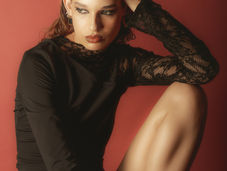Dorothea Tanning Review – Tate Modern
- Godelieve de Bree
- Mar 2, 2019
- 3 min read
27th February to 9th June 2019
Standard Ticket £13
Concession £12
Tate Collective - £5
This is the first exhibition to span Dorothea Tanning’s seventy-year career and it reflects her as a true master of surrealism. Ann Coxon, one of its curators, explained that Tanning has been “overlooked” by the “narrow prism of art history” and that this exhibition seeks to bring some feminine energy to such a male-dominated sphere and indeed, it does so with verve. Tanning was born in Illinois, USA, where she claimed that “nothing happened but the wallpaper”. Having moved to New York in the 1930s, Tanning found her exposure to, and later adoption of, surrealist art.

Dorothea Tanning Self-Portrait 1944. San Francisco Museum of Modern Art.
The world she paints has an opaline film that renders everything fantastic. She has an ability to transport the onlooker into an alien world that seems to be recognisable but, at a closer look, is exposed as uncanny and eerie. Everything becomes perverted as the domestic sphere looms with threatening figures, realities becomes unconcealed and the familiar is twisted into unsettling scenes. An example of this is her spell-binding and sensitive self-portrait Birthday, which depicts a ghost-like figure with pearlescent skin and skirt sewn with seaweed; the doors behind her extend themselves out into infinity. This is art you really have to allow to soak into your psyche.

Dorothea Tanning Birthday 1942. Philadelphia Museum of Art.
A moment that highlights the particular wonder of Tanning is in the second room: Door 84 hangs large and expressive, full of huge brush strokes with two figures separated with an actual segment of a door; it is aflame in its vibrancy and energy. On the adjacent wall, however, hangs one of her most famous pieces Eine Kleine Nachtmusik depicting a large and languid sunflower, as well as two doll-like girls who seem possessed. Here, the angular and exact of the hotel room sit uncomfortably—tensely even—along the decayed sense of normality. The hairs of the sunflower stem, the folds of cloth and the reflection of light on hair: every delicate detail of this painting is awe-inspiring. This composed, tight and precise work is where Tanning's skill really radiates. You cannot help but feel bewitched and on edge when this work is coupled with rich red walls, that feel like thick, hot blood running their way through the exhibition space. It is marvellous.
The spectrum of loose and tight is a particularly applicable lens to look at her work, as one moves into her more “prismatic” paintings. These are much larger canvases with a kaleidoscopic effect that splinters forms and blurs boundaries. Bodies are fragmented, twisted into excess, anatomy is unrecognisable as faces appear to stare out of a wild and obscuring cloud. Insomnies, which Coxon described as playing a "game of revealing and concealing", is a beautiful instance of this, as ribbons of light and colour weave themselves through figures and shadows; one is lucky to spot a toe, a thigh, a foot, in a wild and thick haze of abstraction.

Dorothea Tanning Maternity 1946-1947. Private Collection.
The rooms themselves also shift from spacious to restricted and you are re-born into the last wide hall. This hall, in my opinion, sees the only blemish in Tanning’s body of work: her soft sculptures. With them, there is an absence of subtlety and I would even go as far as to call them meretricious. Entreinte, which sees a human form curled into an animal form, two bodies leaning into one another in a co-dependent manner, is shrug-worthy. Similarly, Pincushion to Serve as a Fetish, a black velvet form pierced with pins, is unimpressive. The craft of these sculptures can be admired but in comparison to her paintings they are second-rate.

Dorothea Tanning Entreinte 1969. Museo Nacional Del Centro de Arte Reina Sofia.
Despite this, Tanning demonstrates herself to have a mastery of countless forms of media: delicate self-portraits become massive, pulsating canvases, which becomes her set and costume designs for ballets, which then transforms into an instillation piece. This exhibition constantly metamorphosises into a new beast. I cannot wait to return again and again to the trance that Tanning evokes and could not recommend going enough to experience it for yourself: it is an absolute pearl in the hands of the Tate Modern, teeming with sophisticated, psychological work, as well as beautiful, thoughtful curation.
Edited by Evangeline Stanford, Digital Editor
























Comments